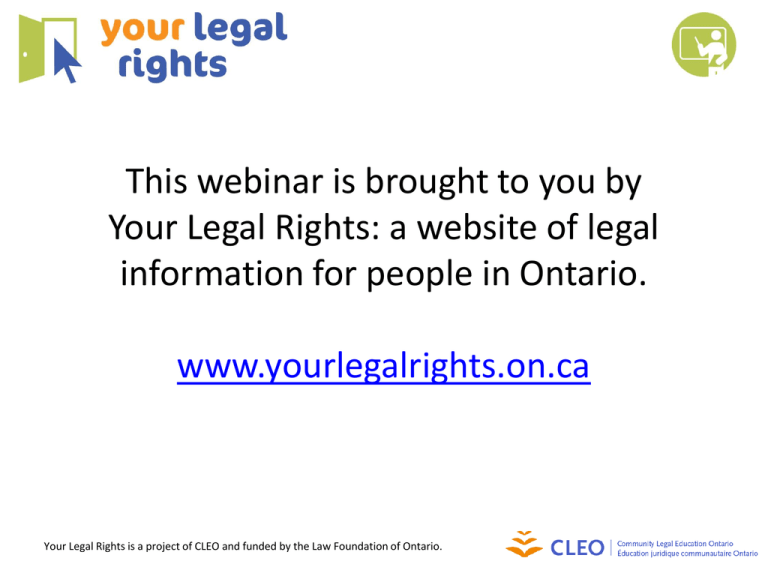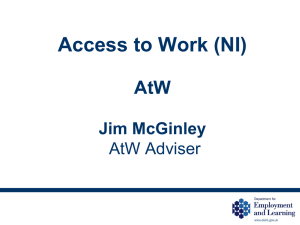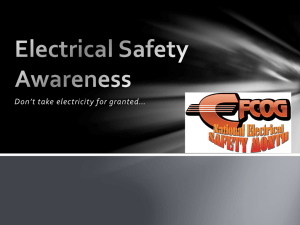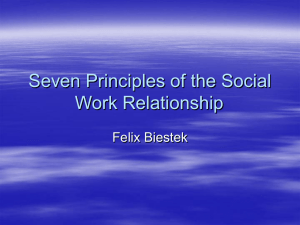Adjudicating the work-relatedness of chronic
advertisement

This webinar is brought to you by Your Legal Rights: a website of legal information for people in Ontario. www.yourlegalrights.on.ca Your Legal Rights is a project of CLEO and funded by the Law Foundation of Ontario. "Work-related Psychological Injury: When and How to Seek WSIB Benefits" Airissa Gemma, Community Legal Worker Maryth Yachnin, Staff Lawyer IAVGO Community Legal Clinic CLEONet Webinar November 24, 2011 Please Note: The content of this webinar is based on law that was current on the date the webinar was recorded. Your Legal Rights webinars contain general legal information. They are not intended to be used as legal advice for a specific legal problem. For more information on how to find a lawyer or to contact your local community legal clinic visit: www.yourlegalrights.on.ca/find-services Your Legal Rights is a project of CLEO and funded by the Law Foundation of Ontario. About our facilitators… Airissa Gemma has been an advocate at IAVGO for more than 30 years, and has represented hundreds of injured workers in navigating the complex legal and policy framework of workers' compensation in Ontario. Maryth Yachnin joined IAVGO full-time in 2009, after practicing at a litigation boutique and working with two public inquiries. She was called to the bar in 2005. Your Legal Rights is a project of CLEO and funded by the Law Foundation of Ontario. IAVGO Community Legal Clinic IAVGO is a community legal clinic founded in 1975 to advocate alongside injured workers. IAVGO provides free legal services to low-income injured workers, and engages in law reform regarding workers’ compensation in Ontario, as well as public legal education. This presentation provides general information only. For specific legal questions, please contact a lawyer or call IAVGO for advice specific to the case. IAVGO Community Legal Clinic 489 College St., Suite 203, Toronto ON M6G 1A5 (416) 924-6477 www.iavgo.org Types of Psychological Injury Compensable What kinds of psychological (non-organic) injury are recognized by the Workplace Safety & Insurance Board (WSIB)? Psychotraumatic Injury o (OPM Document 15-04-02) Chronic Pain Disability (CPD) o (OPM Document 15-04-03) Traumatic Mental Stress o (OPM Document 15-03-02) Basic Workers’ Compensation Principles Apply Was the work one significant contributing factor to the psychological injury, on a balance of probabilities? Thin skull rule – You take your victim as you find them Merits and justices Benefit of the doubt Excluded Injuries – Chronic Mental Stress What kinds of psychological injury are not compensable by the WSIB? • “Chronic” mental stress o Workplace Safety and Insurance Act, s. 13(4)&(5): 13 (4) Except as provided in subsection (5), a worker is not entitled to benefits under the insurance plan for mental stress (5) A worker is entitled to benefits for mental stress that is an acute reaction to a sudden and unexpected traumatic event arising out of and in the course of his or her employment. However, the worker is not entitled to benefits for mental stress caused by his or her employer’s decisions or actions relating to the worker’s employment, including a decision to change the work to be performed or the working conditions, to discipline the worker or to terminate the employment. o o only a bar where the chronic mental stress is not secondary to a physical work-related injury, but rather is caused by “mental” work conditions (e.g. overwork, harassment, witnessing traumatic events without suffering physical injury, etc.) Statutory limitation only applies to post-1998 injuries. Although the WSIB policy 15-03-02 states it applies to all injuries after 1989, the WSIAT should not apply it to pre-98 injuries. Categories of Injury: Cause and Effect • Physical-Physical Claims o o o o sudden onset gradual onset or disablement occupational disease some chronic pain disabilities • Physical-Mental Claims o o o o head injuries exposure to neurotoxins psychological reactions to physical injuries (and their consequences) some chronic pain disabilities • Mental-Physical Claims o heart attack secondary to mental stress (no limits on compensability) • Mental-Mental Claims o o acute reaction to a sudden, shocking or lifethreatening event chronic mental stress “Psychotraumatic” Injury Psychological Disability - lay definition = any impairment in psychological functioning. Psychotraumatic Disability - WSIB definition = a secondary condition which impairs worker’s psychologically and is related to a work-related physical injury and/or its sequalae. Not a medical term Term has led to some adjudicators and board doctors to deny psychological entitlement because an accident was not “traumatic” totally wrong in law and not what policy says Psychotraumatic Disability: Policy Requirements OPM Document 15-04-02, Psychotraumatic Disability: o o o o o Psychotraumatic disability must manifest within 5 years of injury or last surgical procedure (some evidence of condition within 5 years). Psychotraumatic disability can arise from an emotional reaction to the accident or injury or treatment process, or to a severe physical disability. Psychotraumatic disability is also compensable if it “is shown to be related to extended disablement and to non-medical, socioeconomic factors, the majority of which can be directly and clearly related to the work-related injury.” Organic brain injuries also compensated under this policy. The WSIB can pay for health care for non-work-related psychological injuries if it will assist in reducing costs. Psychotraumatic Disability: Practical Tips Many workers who suffer work-related injuries and loss of employment suffer some psychological harm, so advocates should be alert to the issue in every case. o Broach either CPD or psych disability with sensitivity to the stigma attached to mental health issues. It can help to put it in context of that many workers develop these conditions after a work accident, and that the law compensates for this. o If your client develops a psychological injury after having suffered a physical workplace injury, much better to claim as a psychotraumatic injury than as traumatic mental stress. o Psychotraumatic injury is often the additional injury that can allow a worker to be considered “severely impaired” by the WSIB, and possibly be entitled to full loss of earnings and other additional benefits. Psychotraumatic Disability: Practical Tips (Cont’d) Although not specifically required by the policy, workers must generally have a DSM-IV diagnosis by a psychiatric specialist to be considered for entitlement. o In requesting a medical report, be sure to clarify the legal standard (more likely than not that the work or its sequalae were one significant contributing cause of the injury) as well as the policy requirements where helpful. WSIB adjudicators are supposed to recognize warning signs for psychotraumatic injury, but in practice rarely if ever do so until the situation escalates to a severe level or the worker expressly raises the issue. o If your client is having trouble accessing psychiatric care, you might try to convince the WSIB to fund some temporary psychological counselling. Adjudicators are encouraged in their internal training materials to fund treatment where an emerging non-organic condition is becoming a barrier to recovery, return-to-work or successful labour market re-entry. In these cases, the WSIB can pay for a psychiatric or psychological assessment regardless of whether entitlement is accepted for the psychological condition. Practically speaking, the treatment sessions may found the evidentiary basis for entitlement. Psychotraumatic Entitlement: Hearing Tips What to cover with the worker at an oral hearing? o o o o o o o Pre-accident work history Pre-accident hobbies and social activities Description of injury and its psychological effect History of development of psychological concerns Other non-work-related stressors (e.g. family) What are worker’s symptoms? Sleep, concentration, etc. What is the worker’s daily routine since the psychological disability started? Medical treatment “Chronic Pain Disability” WSIB definition = a pain syndrome which begins with a physical injury to the body, followed by pain which last beyond the normal healing time for that injury and is accompanied by marked life disruption. Not always the same as medical understanding of chronic pain, so be careful assuming client has WSIB CPD because doctor diagnoses chronic pain. Chronic Pain Disability: Policy Requirements OPM 15-04-03, Chronic Pain Disability: If pain is predominantly attributable to an organic cause or to the psychiatric conditions of post-traumatic stress disorder or conversion disorder, the worker will be compensated pursuant to the WSIB's policy on that organic or psychiatric condition. If the chronic pain arises predominantly from psychological sources or undetected organic sources, the pain will be considered under the CPD policy. If workers receives CPD entitlement, assumed to have a permanent impairment (as opposed to psychotraumatic, which is assumed to be temporary) Chronic Pain Disability: Policy Requirements (Cont’d) Under the policy, must meet ALL of the following criteria: o o o o o A claim for compensation for an injury has been submitted and accepted. Chronic pain is caused by the injury, as proven by: o subjective or objective medical or non-medical evidence of the worker's continuous, consistent, and genuine pain since the time of the injury, AND o a medical opinion that the characteristics of the worker's pain (except its persistence and/or its severity) are compatible with the worker's injury, and are such that the physician concludes that the pain resulted from the injury. The pain persistsPain 6 or more months beyond usual healing time of the injury, Chronic Disability: PolicytheRequirements proven by subjective or objective medical or non-medical evidence of the worker's continuous, consistent and genuine pain for 6 or more months beyond the usual healing time for the injury. The degree of pain is inconsistent with organic findings, with medical opinion which indicates the inconsistency. The chronic pain impairs earning capacity, with subjective evidence supported by medical or other substantial objective evidence that shows the persistent effects of the chronic pain in terms of consistent and marked life disruption. Marked life disruption must be evident in the worker’s occupational, social and home life. Specific Conditions Covered under CPD Policy OPM 15-04-03, Chronic Pain Disability: • Fibromyalgia, somatoform pain disorder and disabling head pain following minor head trauma with no organic findings are compensated under the CPD policy • Characteristics of fibromyalgia include: chronic diffuse pain of unknown aetiology attributable to either undetected organic condition or psychogenic sources the presence of "tender points" in predictable, and usually symmetrical, locations fatigue and sleep disorders. Chronic Pain: Practical Tips The genuineness of pain is one of the criteria for CPD, so worker’s credibility is crucial. In preparing for hearing, see the “Checklist for chronic pain claims” in Chapter 10 of the Workers’ Compensation: A Manual for Workers’ Advocates (3rd ed.), published by IAVGO and CLEO, available at www.yourlegalrights.on.ca. Consider downside risk before pursuing CPD where a worker already has an organic permanent impairment award, especially a high one. The new permanent impairment award for CPD will generally replace the organic award (with some exceptions for fibromyalgia). How To Advise Injured Worker – Psychotraumatic or CPD? Psychotraumatic? o Looking at the medical information: o o o CPD? o terms like anxiety or depression, or sometimes adjustment disorder, mood disorder Presence of a significant organic impairment Where the medical evidence is not clear, preference for psych because of global rating principle in CPD. For CPD, there is one permanent impairment (PI) award based on a psychiatric assessment of the worker’s level of functioning. For psychotraumatic entitlement, worker gets both an organic PI and one for the psychological injury. Looking at the medical information: o o o terms like functional impairment, chronic pain, myofascial pain, pain syndrome, somatoform pain disorder Extended period of disability and pain beyond normal healing time & failed attempts at getting treatment for the pain & a comparatively small amount of organic impairment compared to pain In some cases, appropriate to ask for CPD or psychotraumatic as alternatives and see what sticks Mental Stress: Policy Requirements OPM Document 15-03-02, Traumatic Mental Stress: • A traumatic event may be a result of a criminal act, harassment, or a horrific accident, and may involve actual or threatened death or serious harm against the worker, a coworker, a worker’s family member, or others. • In all cases, the event must arise out of and occur in the course of the employment, and be • clearly and precisely identifiable • objectively traumatic, and • unexpected in the normal or daily course of the worker’s employment or work environment. • The event is generally accepted as being traumatic. Mental Stress: Policy Requirements (Cont’d) Sudden and unexpected traumatic events include (not exclusive): o o o o o o o o witnessing a fatality or a horrific accident witnessing or being the object of an armed robbery witnessing or being the object of a hostage-taking being the object of physical violence being the object of death threats being the object of threats of physical violence where the worker believes the threats are serious and harmful to self or others (e.g., bomb threats or confronted with a weapon) being the object of harassment that includes physical violence or threats of physical violence (e.g., the escalation of verbal abuse into traumatic physical abuse) being the object of harassment that includes being placed in a life-threatening or potentially life-threatening situation (e.g., tampering with safety equipment; causing the worker to do something dangerous). Mental Stress: Policy Requirements (Cont’d) Cumulative effect: Due to the nature of their occupation, some workers, over a period of time, may be exposed to multiple, sudden and unexpected traumatic events resulting from criminal acts, harassment, or horrific accidents. If a worker has an acute reaction to the most recent unexpected traumatic event, entitlement may be in order even if the worker may experience these traumatic events as part of the employment and was able to tolerate the past traumatic events. A final reaction to a series of sudden and traumatic events is considered to be the cumulative effect. Where the acute reaction is immediate, the WSIB will accept the claim if an appropriately regulated health care professional confirms the worker is suffering from an Axis I diagnosis which may include but is not limited to acute stress disorder post-traumatic stress disorder adjustment disorder, or an anxiety or depressive disorder, in accordance with the DSM-IV. The decision-maker may, at a later point, require an assessment by a psychiatrist or psychologist to confirm ongoing entitlement. Current State of the Law on Mental Stress at the WSIAT Entitlement has been granted in the following types of situations at the Workplace Safety and Insurance Appeals Tribunal (WSIAT): Physical acts with potential for violence (angry supervisor put hand on worker's shoulder) Sexual harassment and investigation into that harassment by employer (not just actions in employment function) Excessive scrutiny by supervisor (not justified as normal staff directions) and vexatious pursuits by co-workers Near miss situations Wrongful accusations of wrongdoing (e.g. false accusation of sexual assault) Current State of the Law on Mental Stress at the WSIAT (Cont’d) But, more recently Tribunal is taking a more restrictive approach; more in line with the plain language of WSIB policy. o E.g, Decision No. 3022 07, "The types of traumatic events that may form the basis for entitlement are broader than those listed in Board policy but the list in the policy should be considered instructive, although not necessarily exhaustive, of the kinds of events that fall within the policy. The items on the list suggest that entitlement applies when the circumstances are very serious, and where a threat to personal security is at least implicit. This must be considered from an objective perspective and not solely from the perspective of the aggrieved party. The policy does not apply when the facts amount only to unpleasant or hostile interactions between co-workers. Further, management actions must go beyond an employer's decisions that are part of the employment function. The actions of management have to be egregious or carried out in bad faith. Overzealous scrutiny carried out for the purposes of accomplishing work functions is insufficient to come within the provisions of the Act for entitlement.“ A number of cases have found there must be objective physical threat to personal security. Recently, one Panel asked the WSIB for submissions on whether the policy, which appears to require actual or implied threat of physical violence, is consistent with the Act; Decision No. 483 11 I (false accusation case) Average Worker Test: The WSIAT’s Limitation on Entitlement Even prior to the statutory bar, the Tribunal often imposed a different test on mental stress claims, called the average worker test. It is usually formulated as follows: 1. Is it reasonable that workers of average mental stability would perceive the workplace events to be mentally stressful? 2. If so, would such average workers be at risk of suffering a disabling mental reaction to such perceptions? Challenges to Constitutionality of the Mental Stress Limitations A number of challenges are going ahead at the Tribunal arguing that the statutory bar on entitlement is discriminatory and violates the Charter; see e.g. Decision No. 2157 09 I2 Case bolstered by B.C. Court of Appeal Plesner decision and subsequent proposed changes to their policy and legislation, expanding scope of entitlement to cover harassment and bullying. Tips for Arguing TMS Cases ● Like all other cases, stress must be work-related - so e.g. not harassment because of personal relationships. ● Consider downside risk of claiming WSIB benefits for harassment type cases without elements of threat of violence (or other unlikely to succeed mental stress cases). If worker also has a separate cause of action (e.g. human rights), consider if a negative WSIB decision on the facts could present an obstacle in the other claim. Don’t focus too much on concepts like human rights violations, etc., since the most important question is always work-relatedness of injury, and the WSIB and WSIAT are not very good at these issues in any event. Assessing Permanent Impairment Awards for Psychological Injury For post-1990 cases, NELs assessed using the chart in OPM Document 18-05-11, Assessing Permanent Impairment Due to Mental and Behavioural Disorders For pre-1990 cases, pensions assessed using the chart in OPM Document, 15-04-02, Psychotraumatic Disability % of NEL/pension award important for what it says about employability More success usually in appeals of psych/CPD pensions or NELs than or organic awards. Useful Resources WSIB policies – www.wsib.on.ca WSIAT decisions – www.wsiat.on.ca or CanLii Workers’ Compensation: A Manual for Workers’ Advocates (3rd ed.), published by IAVGO and CLEO, is available at yourlegalrights.on.ca. This webinar was brought to you by Your Legal Rights: A website of legal information for people in Ontario For more information visit the Employment and Work section of Your Legal Rights at www.yourlegalrights.on.ca For more public legal information webinars visit: www.yourlegalrights.on.ca/training





